For an entrepreneur in the quickly changing e- commerce world, choosing the right platform where to expose and display your products is essential for success. Among the plethora of options available, three juggernauts stand out: Etsy, Amazon, and Shopify.
These platforms individually provide unique set of features which ensures that different sellers can be accommodated based on individual needs and business plans. Having a strong online presence becomes a critical field as any professional intends to navigate the intricacies of these platforms.
- Fees and Pricing Structure
- Marketing and Promotions
- Branding and Customisation
- Customer Support For Sellers
- Payment and Checkout
- Seller Policies
- Which one is Best for Digital products?
- Which one is Best for Print on Demand?
- Which one is Best for Dropshipping?
- Which one is Best for Beginners?
- Which one is Cheaper?
- Official Links to Open Shops On Marketplaces
- Wrapping Up
This in-depth guide unravels the hidden mysteries of Etsy, Amazon, and Shopify, examining their underlying mechanisms, benefits, and pricing policies.
Take a look below for a vast comparison of these marketplaces –
| Feature | Etsy | Amazon | Shopify |
|---|---|---|---|
| User Experience | Specializes in handmade, vintage, and unique items. User-friendly interface. Easy navigation. Aesthetic storefronts. | Wide range of products available. Simple and intuitive interface. Streamlined search and browsing. Familiar layout. | Customizable branded stores. Intuitive interface. User-friendly navigation. Clean and modern design. |
| Product Diversity | Focuses on handmade, vintage, and unique items. Niche markets and specialized categories. Artisanal goods. Limited to specific product types. | Diverse range of products available. Includes virtually all product categories. High volume of listings. Generic and branded goods. | Offers a wide range of products. Supports various industries and niches. Customizable product offerings. Can accommodate digital and physical goods. |
| Fees and Pricing Structure | Listing fee: $0.20 per item. Transaction fee: 5% of sale price. Payment processing fee: 3% + $0.25. Optional advertising fees. No monthly subscription fee. | Variable referral fees by category (usually 6-45%). Professional selling plan: $39.99/month (individual plan available). Additional fees for fulfillment services (FBA). | Monthly subscription plans starting from $29/month. Transaction fees: 2.9% + $0.30 (online). Additional fees for payment processing and third-party apps. |
| Marketing and Promotions | Promoted listings. Social media integration. Email marketing tools. SEO optimization. Community engagement. Limited advertising options. | Amazon Advertising (Sponsored Products, Sponsored Brands, etc.). Amazon Prime eligibility. Cross-promotion through Amazon affiliates. SEO optimization. Email marketing through Amazon’s platform. | Built-in marketing tools (discount codes, gift cards, etc.). Integration with social media platforms. Email marketing apps integration. SEO features. Limited in-platform advertising options. |
| Brand Identity | Limited customization options. Focus on individual seller branding. Uniform storefront design. Shop announcement and banner customization. | Limited storefront customization. Emphasis on Amazon’s brand. Seller profiles and logos. Brand registry for trademarked brands. Customizable product listings. | Highly customizable storefronts. Full control over branding and design. Custom domain integration. Unique themes and templates. Customizable checkout experience. |
| Customer Base and Traffic | Targeted audience interested in handmade and unique items. Smaller but engaged community. Moderate to high traffic volume. Niche market appeal. | Massive global customer base. High traffic volume. Diverse demographics. Highly competitive market. Potential for exposure to millions of customers. | Relies on seller’s marketing efforts for traffic. Growing customer base. Targeted traffic based on marketing strategies. Opportunity for SEO optimization. |
| Customer Support | Limited customer support. Help Center and community forums. Email support for sellers. Resolution Center for disputes. No direct phone support. | Extensive customer support. Help Center and FAQs. 24/7 phone support. Email support. Seller forums and community. | 24/7 customer support. Help Center and resources. Email and live chat support. Community forums and Shopify Academy. Dedicated support for merchants. |
| Payment and Checkout | Etsy Payments integration. Multiple payment options (credit/debit cards, PayPal, etc.). Secure checkout process. Guest checkout available. | Amazon Payments integration. Secure payment processing. One-click ordering with Amazon Prime. Guest checkout available. Multiple payment options. | Shopify Payments integration. Multiple payment gateways available. Secure checkout process. Guest checkout available. Automatic tax calculation. |
| Seller Policies | Strict policies on handmade, vintage, and unique items. Intellectual property protection. Seller protection policies. Transparency on fees and charges. Review guidelines and seller performance standards. | Stringent policies on product quality and authenticity. Intellectual property protection. Seller performance metrics and standards. Return and refund policies. Compliance with Amazon’s terms of service. | Flexible policies on product types. Intellectual property protection. Seller protection policies. Customizable return and refund policies. Compliance with Shopify’s terms of service. |
Fees and Pricing Structure
Charges and fee schedule can be quite distinctive from Etsy, Amazon and Shopify. Etsy charges $0.20 per item list, a sale transaction fee of 6.5%, and a 5% + $0.25 payment processing fee. While Etsy is with no charge for a monthly subscription fee, sellers may go for additional advertising fees.
Amazon couples its varying referral fees by category, with an average range of 6%-45%, plus a monthly fee of $39.99 for its professional selling plan. The use of shipping services through the Amazon FBA program will add up the fees.
Shopify offers up monthly subscription plans as low as $29 with an online transaction fee of 2.9% plus $0.30 per transaction. Sellers can be charged additionally for payment processing and plugins.
| Fee | Etsy | Amazon | Shopify |
|---|---|---|---|
| Listing Fee | $0.20 per item | N/A | N/A |
| Transaction Fee | 6.5% of sale price, $15 flat fees for new shops (One time fees) | Variable referral fees (6-45%) | 2.9% + $0.30 (online) |
| Payment Processing Fee | 5% + $0.25 | N/A | Additional fees may apply |
| Monthly Subscription | N/A (Optional) | $39.99 (Professional plan) | Starts from $29/month |
| Fulfillment Fees | N/A | Additional fees for FBA | N/A |
| Advertising Fees | Optional | Additional fees for advertising options | Limited in-platform advertising options |
Marketing and Promotions
The e-commerce market is very competitive. Smart marketing guarantees the required sales and visibility. Etsy, Amazon, and Shopify are different ways of reaching customers online with products as well as fulfilling the audiences.
Etsy has the promoted listings, social media integration and email marketing as its tools that it uses to promote its niche customers and to create an active customer community.
In comparison to Shopify, Amazon comes with strong advertising options, such as Sponsored Products and Prime Eligibility, but Shopify has built-in features such as discount codes, social media integration and SEO advantages.
Designing blended approaches is a principle for making the most of these tools.
| Marketing Feature | Etsy | Amazon | Shopify |
|---|---|---|---|
| Promoted Listings | Yes | No | No |
| Social Media Integration | Yes | Limited | Yes |
| Email Marketing Tools | Yes | Yes | Yes |
| Advertising Options | Limited | Amazon Advertising (Sponsored Products, Sponsored Brands, etc.) | Limited in-platform advertising options |
| Prime Eligibility | No | Yes | No |
| Cross-promotion | No | Through Amazon affiliates | No |
| Discount Codes | No | No | Yes |
| SEO Features | Yes | Yes | Yes |
Calculate all kind of Etsy fees using our advance Etsy fees calculator –
Branding and Customisation
Brands’ identity is crucial for online selling business success as it helps the seller to stand out in a highly competitive market. Etsy, Amazon, and Shopify are different from each other and provide the brands a chance to build them up.
Etsy, famous for its hand-made items, permits limited non-standard customization within a strictly defined frame. Amazon insists on its own brand yet lets some sellers monogram.
Shopify has features that are flexible granting the ability to control checkouts, domains, and design. Deciding on the platform means realizing what customization options match the brand goals.
| Aspect | Etsy | Amazon | Shopify |
|---|---|---|---|
| Storefront Customization | Limited customization options | Limited storefront customization | Highly customizable storefronts |
| Branding Control | Focus on individual seller branding | Emphasis on Amazon’s brand | Full control over branding and design |
| Store Announcement Customization | Available | Limited | Available |
| Logo Customization | Available | Available | Available |
| Custom Domain Integration | Limited | Limited | Available |
| Theme and Template Customization | Limited | Limited | Unique themes and templates |
| Checkout Customization | Limited | Limited | Customizable checkout experience |
| Community Engagement | Yes | Seller forums and community | Shopify Academy and community forums |
| Support for Brand Registry | No | Yes (for trademarked brands) | No |
Customer Support For Sellers
Customer support is the backbone of online tools that helps uphold smooth communication and solve problems. Etsy, Amazon, and Shopify have their own, distinct supporting systems.
Etsy gives help center support, email, and forum services, all community-driven. Amazon provides an absolute support including Help center with comprehensive information of how-to, phone support, email service, and community forum.
Similarly, Shopify support team works 24/7, Help Center which is also thorough, and there are email/live chat, forums, and educational materials.
The choice of the platform will, however, largely rely on the level of support required to effectively handle obstacles and propel the business upwards.
| Aspect | Etsy | Amazon | Shopify |
|---|---|---|---|
| Customer Support Channels | Help Center, Email Support, Community Forums | Help Center, 24/7 Phone Support, Email Support, Seller Forums | Help Center, Email and Live Chat Support, Community Forums, Shopify Academy |
| Availability | Limited | Extensive | Extensive |
| Response Time | Varies | Varies | Varies |
| Educational Resources | Limited | Comprehensive | Comprehensive |
| Resolution Channels | Help Center, Email Support, Resolution Center | Help Center, 24/7 Phone Support, Resolution Center | Help Center, Email and Live Chat Support, Resolution Center |
| Community Engagement | Yes | Yes | Yes |
Payment and Checkout
Efficient payment and checkout mechanisms are indeed the foundation of success; it makes it easy to make transactions for sellers and buyers. Both Etsy, Amazon and Shopify provide customized experiences for their respective seller communities.
Among the services provided by Etsy Payments are the availability of various payment options, secure checkout, and guest checkout.
To state a few of the case such as secure payment processing, one click ordering with Amazon Prime and diverse payment options using Amazon Payments, all of these are available in Amazon.
Shopify provides different web-based payment gateways, safe check out, guest checkout, and automatic tax calculation by integrating with Shopify Payments. Selecting the right platform has to do with how the provider current suits seller’s commerce needs in terms of payment and checkout.
| Aspect | Etsy | Amazon | Shopify |
|---|---|---|---|
| Payment Integration | Etsy Payments | Amazon Payments | Shopify Payments |
| Payment Options | Credit/debit cards, PayPal | Amazon Payments, Credit/debit cards | Credit/debit cards, PayPal, other gateways |
| Secure Checkout | Yes | Yes | Yes |
| Guest Checkout | Available | Available | Available |
| One-click Ordering | No | Yes (with Amazon Prime) | No |
| Automatic Tax Calculation | No | No | Yes |
| Multiple Payment Gateways | Yes | Limited | Yes |
Seller Policies
E-commerce policies are central for the seller experience under Etsy, Amazon, and Shopify. Each platform determines its unique rules conforming to its code of conduct and user preferences.
Etsy’s central focus of handmade, vintage, and unique items ensures strong intellectual property protection and high performance standards for its sellers.
Amazon caters the product authenticity and customer satisfaction by introducing these quality control measures like quality control measure, seller performance metrics and return/refund policies.
Unlike this, Shopify takes up policies with flexible conditions that accept diverse products. Further, it has provisions for intellectual property security and customizable return/refund policies.
| Aspect | Etsy | Amazon | Shopify |
|---|---|---|---|
| Product Guidelines | Emphasis on handmade, vintage, and unique items | Stringent quality control measures | Flexible policies accommodating various product types |
| Intellectual Property | Protection measures in place | Protection measures in place | Protection measures in place |
| Seller Performance | Standards in place for seller performance | Metrics and standards for seller performance | Standards for seller performance |
| Return/Refund Policies | Standard policies with some customization options | Standard policies with some customization options | Customizable return/refund policies |
| Compliance | Review guidelines and adherence to performance standards | Compliance with Amazon’s terms of service | Compliance with Shopify’s terms of service |
Which one is Best for Digital products?
Shopify conquers the throne as the primary space for ecommerce of digital products. Providing unmatched adaptability for sellers, Shopify, thanks to its comprehensive structure and indivisible properties.
The user-friendly interface lets an artist express themselves and sell digital goods such as e-books, software, courses, and art.
Shopify smooths the way for various digital delivery services, which in the end guarantees a secured transaction and a customized checkout experience.
Working on that assigned homework has been one of the greatest learning opportunities I have ever faced during my college years.
Ease of use is also offered to the customers as the automatic tax calculations is available. In addition, a rich variety of apps and plugins offers the best framework and instrument for product management on the internet, making Shopify the leaders in industry.
| Aspect | Etsy | Amazon | Shopify |
|---|---|---|---|
| Digital Product Support | Limited support for digital products | Limited support for digital products | Extensive support for digital products |
| Storefront Customization | Limited customization options | Limited customization options | Highly customizable storefronts |
| Payment Integration | Limited options for digital product sales | Limited options for digital product sales | Integrated support for digital product sales |
| Digital Delivery Options | Limited integration with digital delivery services | Limited integration with digital delivery services | Seamless integration with digital delivery services |
| Security Features | Basic security measures | Basic security measures | Enhanced security features for digital products |
| App Ecosystem | Limited digital product management apps/plugins | Limited digital product management apps/plugins | Wide range of apps/plugins for digital product sales |
| Pricing Structure | Transaction fees and optional advertising fees | Variable referral fees and subscription plans | Monthly subscription plans with transaction fees |
Which one is Best for Print on Demand?
For POD (Print on Demand) services, Shopify is definitely the clear winner. Its integration with the industry’s leading print-on-demand services like Printful and Printify makes it very easy to create the products and fulfill the orders.
Shopify’s easy customization of storefronts, secure payment processing, and wide app ecosystem are what make it the most popular print-on-demand platform.
| Aspect | Etsy | Amazon | Shopify |
|---|---|---|---|
| Print on Demand Support | Limited support for print-on-demand services | Limited support for print-on-demand services | Extensive support for print-on-demand services |
| Integration with POD Apps | Etsy have Limited integration with print-on-demand apps | Limited integration with print-on-demand apps | Seamless integration with leading POD apps |
| Product Customization | Limited customization options | Limited customization options | Highly customizable product creation |
| Payment Integration | Multiple payment options | Multiple payment options | Integrated payment processing |
| Order Fulfillment | Basic order fulfillment services | Basic order fulfillment services | Advanced order fulfillment capabilities |
| App Ecosystem | Limited selection of print-on-demand apps/plugins | Limited selection of print-on-demand apps/plugins | Extensive selection of print-on-demand apps/plugins |
Which one is Best for Dropshipping?
Drop-shipping trend sets Shopify as the dominant platform. Using Oberlo and Spocket, which are the dropshipping apps that are integrated seamlessly into the Shopify platform, dropshippers can simplify product sourcing, fulfillment of orders, and management of their inventory.
Shopify’s easy to customize Storefronts, secure payment processing, and advanced app Ecosystem makes it the ideal choice for dropshipping.
| Aspect | Etsy | Amazon | Shopify |
|---|---|---|---|
| Dropshipping Support | Limited support for dropshipping services | Limited support for dropshipping services | Extensive support for dropshipping services |
| Integration with Dropshipping Apps | Limited integration with dropshipping apps | Limited integration with dropshipping apps | Seamless integration with leading dropshipping apps |
| Product Sourcing | Limited options for product sourcing | Limited options for product sourcing | Vast selection of products from leading suppliers |
| Inventory Management | Basic inventory management features | Basic inventory management features | Advanced inventory management capabilities |
| Payment Integration | Multiple payment options | Multiple payment options | Integrated payment processing |
| Order Fulfillment | Basic order fulfillment services | Basic order fulfillment services | Advanced order fulfillment capabilities |
| App Ecosystem | Limited selection of dropshipping apps/plugins | Limited selection of dropshipping apps/plugins | Extensive selection of dropshipping apps/plugins |
Which one is Best for Beginners?
A newcomer in e-commerce who is keen on choosing the most suitable platform should go for Shopify. The easy-to-use interface, broad range of features, and specialized support provided ensure that the application is comprehensible for the newcomers.
Hire Etsy Expert
Hiring an Etsy expert to set up your store ensures a smooth launch and maximizes your sales potential. With their expertise, you’ll navigate the platform’s intricacies, optimize product listings, and implement effective marketing strategies, saving time and avoiding pitfalls. Whether you’re new to entrepreneurship or a seasoned seller, an Etsy expert provides invaluable support to achieve your business goals efficiently.
Although new business owners might have some doubts, they can easily create their storefronts which can be customized. In addition, integrating with different apps and using resources such as the Shopify Academy, they can begin selling confidently from the beginning.
| Aspect | Etsy | Amazon | Shopify |
|---|---|---|---|
| User-Friendliness | Moderate | Moderate | High |
| Setup Process | Straightforward | Moderately complex | Straightforward |
| Customization Options | Limited | Limited | Extensive |
| Support Resources | Basic | Basic | Comprehensive |
| Transaction Fees | Listing fee + Transaction fee, $15 flat fees for new shops (One time fees) | Referral fees | Transaction fees + Subscription fee (optional) |
| Payment Integration | Etsy Payments | Amazon Payments | Shopify Payments |
Which one is Cheaper?
Price offers are the reason why Etsy is a cheaper place to buy goods within e-commerce platforms. Etsy is a platform that allows sellers to list their items for free of $0.20 per item and transaction fees of 5%, which makes it a cost-effective option.
Amazon and Shopify, which provide numerous functionalities accompanied by higher fees like referral fees, monthly rebates and additional costs, are in contrast with Etsy, which is a cheaper choice for sellers who aim at minimizing expenditures.
| Aspect | Etsy | Amazon | Shopify |
|---|---|---|---|
| Listing Fee | $0.20 per item | N/A | N/A |
| Transaction Fee | 5% of sale price | Variable referral fees (6-45%) | 2.9% + $0.30 (online) |
| Payment Processing Fee | 3% + $0.25, $15 flat fees for new shops (One time fees) | N/A | Additional fees may apply |
| Monthly Subscription | N/A | $39.99 (Professional plan) | Starts from $29/month |
| Fulfillment Fees | N/A | Additional fees for FBA | N/A |
| Advertising Fees | Optional | Additional fees for advertising options | Limited in-platform advertising options |
Official Links to Open Shops On Marketplaces
| Marketplaces | Official Links |
|---|---|
| Etsy | Open a Shop |
| Amazon | Open a Shop |
| Shopify | Open a Shop |
Wrapping Up
The Etsy vs Amazon vs Shopify debate is a situation that boils down to your specific business requirements, goals, and choices. Etsy stands out for artisans and creators looking for a niche marketplace which depends solely on homemade, vintage or rather unique goods.
Amazon provides unparalleled reach and access to a massive customer-base by spanning a wide array of product categories thus allowing high-volume sellers to find a ready customer-base.
Shopify, on the other hand, allows entrepreneurs to build their own shop and provides the scalability, full branding and customization tool which creates a very good customer experience.
If you’re an e-commerce entrepreneur or online seller using Etsy, it’s essential…
Etsy and TikTok are two powerful platforms that can work hand in…
How to Create AI Arts That Sells on Etsy?
Artificial Intelligence (AI) is revolutionizing the way art is created and sold…
Through this process, you can strategically analyze product type, customer segment, pricing model, and feature availability of your business to actually drive success in the e-commerce space that is rapidly evolving.



